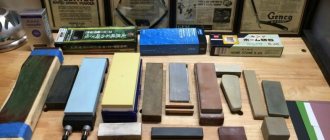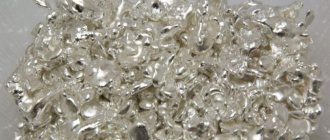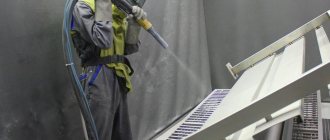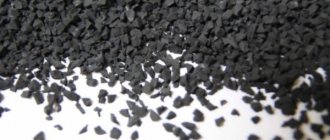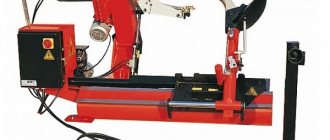When installing various pipeline systems, you have to bend pipes with a round cross-section. If you do not use a pipe bender for a round pipe, then an attempt to bend the workpiece to a certain angle can lead to either collapse of the circular cross-section with a complete loss of the flow area, or a crack may appear at the bend site. Therefore, in order to bend a round pipe, methods were invented and special devices were made.
All pipe benders can be divided according to the method of mechanical action on the round pipe profile. It is worth considering that, despite the external similarity, there are differences in the approach to technology, expressed by differences in the bending technique when acting on a round pipe profile:
- to the cold,
- for hot.
Thus, the most common models of pipe benders that bend a round pipe cold, that is, without additional heating of the bend, include:
- break-in,
- winding,
- crossbow,
- rolling or rolling.
Run-in pipe bender
It is the simplest design and is positioned as a hand-held mobile device. Structurally, it consists of a solid base on which a fixed template of a certain diameter is fixed. A frame lever with a rolling movable roller is attached to the central axis of the template.
The operating principle of this mechanism is simple. To begin with, the workpiece is firmly fixed on a stationary template. Next, using a lever and a crimping roller, they begin to roll the pipe tightly around the template so that it completely follows the bend radius of the template.
The disadvantage of such devices is that the bending radius corresponds to the diameter of the fixed template. This can be partially solved by changing the diameter sizes, by replacing the stationary template and crimping roller, so you can bend pipes with a nominal diameter from 15 to 32 mm.
Factory models are produced that have three templates of different diameters in their design and, accordingly, three rolling rollers designed for bending gas pipes of the main standard sizes.
The advantage of a rolling manual pipe bender is its versatility in use due to the simplicity of the design, which does not take up much space and allows its installation both on a mechanic’s workbench and on almost any temporary surface under construction conditions. Therefore, a rolling pipe bender for a round pipe is most often made by hand than other types of devices.
Features of aluminum as a metal
Bending aluminum in its pure form, as well as its alloys, can have several nuances:
- When obtaining metal, a procedure of artificial or natural aging is most often carried out. This is necessary so that the structure of the source material becomes more stable. As for aluminum itself, similar heat treatment is also required to create a strong surface film of the main oxide AI2O3. It is this protection that prevents corrosion on products made from this material. The film also enhances the strength of the structure, but its ductility suffers.
- Pipe rolling production using aluminum can be carried out by rolling, hot extrusion or extrusion. Recently, the last two technologies have become the most popular, although it is thanks to rolling that the aluminum pipe becomes more durable, but its sensitivity to stress when bending increases.
- Any method of bending a profile due to the peculiarities of the process involves changing the location of the “neutral line”. This is a virtual curve separating the zone under compression stress (which is adjacent to the inside of the pipe being processed) and the tensile section located on the outer surface of the bent product. For this reason, aluminum structures and pipes made from an alloy of this metal most often diverge along the outer rather than the inner radius.
- In construction practice, profiles made of pure aluminum of such brands as AD0, AD33, AD31, etc. are often used. In addition, duralumin products, for example, D1 and D16, are in great demand. Many people choose alloys made of aluminum and manganese.
But it must be taken into account that additional additives can reduce the plasticity of the starting material. If bending an aluminum pipe is carried out at home, the chemical composition of the workpiece is often not taken into account. This leads to failures, for example, to the appearance of a complex spatial contour. For this reason, before starting work, it is necessary to carefully check the grade of the alloy from which the pipe was made. Next, you need to act in accordance with the recommendations for working with a specific metal.
We recommend articles on metalworking
- Steel grades: classification and interpretation
- Aluminum grades and areas of their application
- Defects in metal products: causes and search methods
If the product turns out to be uncertified, you can get information from other sources:
- There should be a marking on the end of the tube. You can decipher it from a reference book, for example, from the first volume of Anuriev’s “Handbook of Mechanical Designers”. The plasticity levels of the material will be indicated here.
- The most accessible way is to tap the pipe with a hammer. The more sonorous the sound, the higher the hardness of the metal.
- You can use a file. Elements of a soft alloy, such as AD0 or AMg6, will stick to the tool. Solid materials peel off from the base.
- All types of duralumin, and especially D16, have low corrosion resistance. Therefore, manufacturers produce such pipes with a surface coating made by anodizing. These are poor options for bending. They can only be rotated a small angle.
- Products made of duralumin will get your hands dirty, so they can be easily distinguished from pure aluminum.
Winding type pipe bender
The principle of operation is similar to the running one, only its design includes a movable template. The workpiece is fixed using a bracket attached directly to the template itself, but instead of a crimping roller there is a fixed thrust shaft.
A winding pipe bender works by rotating a template, which bends the pipe, as if winding it onto a central pulley, which corresponds to the name of the device.
Such devices are manufactured mainly in a factory manner, while the device is equipped with an electric drive of the central pulley through a gear motor for mechanical bending.
Another disadvantage is the limitation associated with the diameter of the central pulley. And in the case of a manual drive, you will need to use a more powerful lever and a large bearing for the central pulley shaft.
The advantages include a simple design and relatively small size.
Crossbow type pipe benders
They are a base with two spaced apart fixed roller supports, on which the pipe blank is laid. The bending process occurs due to the fact that exactly in the middle between the rollers a punch with a certain radius size presses on the workpiece at the place of future bending. The punch is similar in shape to the template, only it represents only a part of it, no more than half a circle in size. The workpiece is bent, like the arc of a bow, on both sides at once, which allows for the least deformation of the pipe cross-section at the bend.
To transfer force to the punch, as a rule, a hydraulic drive is used, hence the crossbow-type device has a second name - a hydraulic pipe bender.
Although, along with hydraulics, designs of manual pipe benders with a screw drive are produced, as a rule, such devices are significantly inferior in performance to the latter and have a more bulky design.
The advantage of a crossbow hydraulic pipe bender is, first of all, the mechanization of the bending process, which requires virtually no physical strength for its work, and the simple replacement of punches makes the device also universal, allowing you to bend almost any small-sized rolled metal product.
The disadvantages include the limitation of the bend radius. And also, for large sizes of workpieces at the stop points, a slight curvature of the cross-sectional diameter of the pipe may occur, but when working with a thin-walled pipe, it can be significantly dented.
Production methods and technical characteristics of aluminum pipes
Rental is carried out in several ways:
- pressing of aluminum parts with a round cross-section;
- cold deformation (drawing, piercing and calibration);
- according to the principle of rolling stainless steel: welding strip or sheet.
Production of aluminum pipes
Modern technologies make it possible to produce cost-effective, high-quality products. The main feature of aluminum is its low weight. Its density (ρ = 2.7 t/m³) is more than 3 times less than ρ of carbon steel (7.85 t/m³). There are other advantages of non-ferrous metal products:
- wear resistance;
- high resistance to moisture;
- flexibility;
- plastic;
- frost resistance;
- excellent weldability;
- high electrical and thermal conductivity;
- environmental friendliness;
- resistance to rust.
One of the disadvantages of aluminum parts is low strength. But this property is compensated by the ease of deformation of the metal without changing the basic characteristics. Excellent plasticity allows you to design and build complex engineering solutions. For the production of profiles, alloys of aluminum with copper, magnesium, zinc, and other metals are often used. They are more durable and withstand variable forces well.
Aluminum pipes are not difficult to transport, loading is not difficult. Profile pipes are inexpensive and easy to install.
Aluminum products
Rolling or rolling pipe benders
They are a structure with three rollers, two of which are stationary, and one, installed in the middle, is capable of moving up and down relative to the other two. This arrangement of the rolling rollers during the forward movement of the pipe allows it to be bent in an arc. With several rolling passes, you can obtain the required bending radius of the pipe.
The disadvantages of the rolling method include the low productivity of manual devices.
The advantage is the ability to bend almost all types of profiles, including thin-walled sizes.
It is worth noting that the rolling bending method has proven itself well on industrial universal bending machines, where mechanical rolling of the workpiece using an electric drive is used, and the number of rolling rollers is determined by the technological map.
Bending a round pipe using a mandrel is a fairly old technology. Thus, there are several types of mandrel, such as:
- rigid in the form of a fixed rod;
- polished with a certain curved shape;
- segmental, consisting of a set of bending segments.
The advantage of this method is that it allows you to bend a round pipe to fairly small radii, almost at a right angle.
Bending methods
The following bending methods can be used in this equipment:
- Pushing . In this case, the aluminum pipe is pushed between the rollers of the machine: one of the rollers is assigned the task of deflecting the workpiece. In this way, an arcuate bend is achieved with a very small radius of curvature. The bend radius is determined by multiplying the pipe diameter by 6.
- Rental _ An aluminum pipe with a diameter of 10 to 100 mm is rolled through bending rollers, which must strictly correspond to the diameter of the pipe being bent. To carry out this operation, a three-roll pipe bender is used, which is capable of bending in the form of a ring, spiral and arc. It can be used to process both round and rectangular profiles. Rolling is carried out in several passes.
- Rolling in . For bending, the rolling head of a pipe bender is used, which bends the workpiece under pressure. In areas without pressure, the pipe bends in the opposite direction. Rolling in is not accompanied by heating. To prevent the workpiece from shrinking, you need to ensure that the minimum bend radius is observed: it is equal to the radius of the pipe multiplied by three.
- Pressure bending . Here, for pressing, stamps are used that deform the workpiece from the outside, or hydroforming, when the pipe is filled with water or oil under pressure to bend it from the inside within the boundaries of the mold.
Pipe bender for profile pipe
Basically, for bending profile pipes, rolling pipe benders are used, on which the rollers are made according to the type of profile in the shape of a rectangular section.
The main difference when bending a rectangular profile from a round pipe is the large bending radii. With a further attempt to reduce the bending radius, a certain deformation of the straight lines of the profile walls begins to occur, which significantly reduces the flow area and reduces the structural properties.
Pipe bending device
A pipe bender for bending pipes allows you to make all bends as efficiently and quickly as possible. This thing has a large number of varieties according to the bending method:
Crossbow. The operating principle of this design is based on the use of a certain shape, which is needed for pipes having a certain diameter
Spring. It is based on a special spring structure made of steel. It helps to avoid deformation and bend plastic pipes with your own hands.
Dornovaya. This design will allow bending pipes with extremely thin walls.
Segmental. The operating principle of this device is based on a special segment that is capable of stretching the product around itself.
How to bend a pipe without a pipe bender
If, nevertheless, you need to bend a round pipe, but you don’t have a manual pipe bender, how to bend the pipe correctly, we can recommend several quite working methods. So:
- You need to fill the pipe with sand, and to prevent the sand from spilling out, temporarily seal the ends with a rag. Having found a rounded surface so that one end of the pipe can be firmly secured using an attachment in the form of a pipe of a larger diameter, of sufficient length for the lever, we gradually bend our workpiece to the required angle.
- In exactly the same way, you can bend a metal pipe of small diameter, using ice chips instead of sand or filling it tightly with snow.
- In order to bend a metal-plastic pipe in your hands without breaking it, you need to insert a spring of a slightly smaller diameter inside the pipe. At the end of the bending process, it should easily come out of the pipe.
If you know another way to bend a round pipe without a pipe bender, then share your experience in the comments block.
Examples of pipe bending in the automotive industry.
| Molded car air conditioner tube. ( ) | Hydraulic system pipe with nuts at the ends. (Special pipe bender) | Rear trunk lid mounting tube. (Tube bending machine MBE) | Rear trunk lid mounting tube. (Tube bending machine MBE) |
| Muffler element for a passenger car. ( ) | Exhaust manifold of a passenger car. ( ) | Muffler element for a truck. ( ) | Vehicle attachments (car carriers). ( ) |
| Car headrest made of tube or wire. (Special pipe bender) | Car seat frame. ( ) | Bending alloy steel torsion bar. ( ) | Bending the muffler bracket with landing. (Special pipe bender) |

